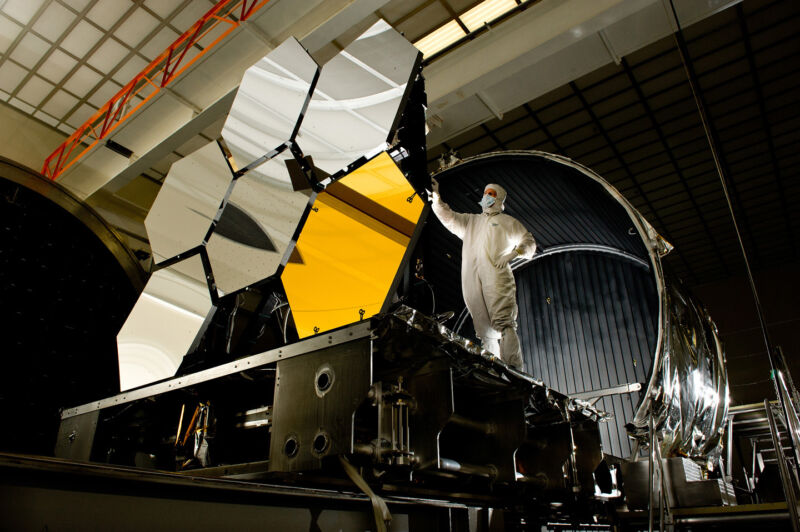NASA is leading an anomaly review board to investigate and conduct additional testing.
ERIC BERGER - 11/22/2021, 3:09 PM

Enlarge / Technician standing near some of the segments of the James Webb Space Telescope primary mirror.
A short update on the projected launch date of the $10 billion James Webb Space Telescope came out of NASA on Monday, and it wasn't exactly a heart-warming missive.
The large, space-based telescope's "no earlier than" launch date will slip from December 18 to at least December 22 after an "incident" occurred during processing operations at the launch site in Kourou, French Guiana. That is where the telescope will launch on an Ariane 5 rocket provided by the European Space Agency.
FURTHER READING Meet the largest science project in US government history—the James Webb Telescope
"Technicians were preparing to attach Webb to the launch vehicle adapter, which is used to integrate the observatory with the upper stage of the Ariane 5 rocket," NASA said in a blog post. "A sudden, unplanned release of a clamp band—which secures Webb to the launch vehicle adapter—caused a vibration throughout the observatory."
Let's be honest, words like "incident," "sudden," and "vibration" are not the kinds of expressions one wants to hear about the handling of a delicate and virtually irreplaceable instrument like the Webb telescope. However, NASA, the European Space Agency, and the rocket's operator, Arianespace, have a plan for moving forward.Advertisement
NASA is leading an anomaly review board to investigate and conduct additional testing to determine with certainty that the incident did not damage any part of the telescope. NASA said it will provide an update when the testing is completed at the end of this week. A senior source at the space agency said this testing is currently running ahead of schedule and that, provided some serious issue is not identified, the December 22 launch date should stick.
Any setbacks now in Webb's progress toward launch feel especially painful because reaching this point has been such a long, long road. NASA's follow-on instrument to the wildly successful Hubble Space Telescope was originally due to launch about a decade ago, with a development cost of $1 billion. Since then, technical problems and delays have bedeviled the complex telescope.
Building Webb has been difficult because its 6.5-meter mirror needs to unfurl itself once it reaches an orbit about 1.5 million kilometers from Earth. This is an exceedingly complex process, and there are more than 300 single points of failure aboard the observatory. NASA has had a difficult time testing them all on Earth in conditions that mimic the temperatures, pressure, and microgravity of deep space.
NASA's science chief, Thomas Zurbuchen, said Monday it was important for NASA to ensure the telescope was healthy before its launch. "I am confident the team will do everything they can to prepare Webb to explore our cosmic past," he wrote on Twitter. "Certainly, this step is worth the wait.
No comments:
Post a Comment